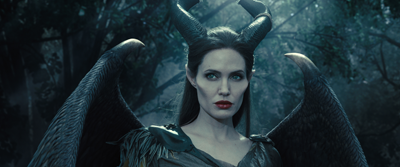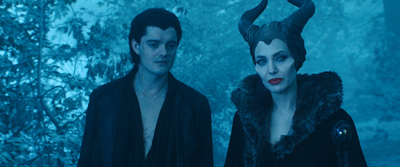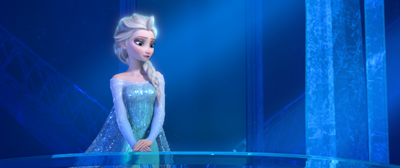WARNING: THAR BE SPOILERS AHEAD FOR “MALEFICENT”, “FROZEN”, AND “OZ THE GREAT AND POWERFUL”. IF YOU DON’T WANT TO BE SPOILED, FORK OUT THE $$ TO WATCH THE FLICKS AND THEN COME BACK!
And so it was that last night, I saw “Maleficent”. In this twist on a classic tale once done up by Disney in animated form, Maleficent is the center of attention. Most tellings of the story of The Sleeping Beauty share the same general elements: a baby girl is born to King Stefan and his Queen; a big party is held to celebrate the baby’s arrival; fairies from across the land are invited to the party and all but ONE bestow gifts of beauty, kindness, etc.; before the final fairy can bestow her gift, she’s rudely interrupted by an evil fairy – Maleficent – who’s terribly offended by the lack of invitation and decides to curse the child to die on her 16th birthday when she pricks her finger on the spindle of a spinning wheel; the final fairy “softens” the curse by instead having her go to sleep until true love’s kiss awakens her; natch, this ALL comes to pass no matter what King Stefan does to prevent it; Prince Philip, who fell in love with the princess when she was incognito turns out to be said true love; AND – key plot point – he slays Maleficent and frees the princess from her sleep by giving her true love’s kiss.
It all sounds so…Disney, right?

Maleficent revealed in adulthood (played by Angelina Jolie)
So, then we have “Maleficent”, where we start out with a backstory of Maleficent as a kind, brave fairy in the Moors, a magical land bordering a wretched kingdom led by a cruel, greedy King. Maleficent saves the life of a young thief, Stefan, whom she befriends and soon falls in love with. In one example of how much he cares, when she tells him that iron burns fairies, the dirt-poor Stefan tosses away an iron ring, probably his sole possession of any value, before it can hurt her again. Over time, their friendship does turn to romance – sealed with a true love’s kiss they share when they’re both teens. As time passes, Maleficent becomes the protector of her magical home, and she turns away the King’s army before it can pillage and plunder. Stefan, now a royal retainer, takes up the King on his offer to become his successor by slaying Maleficent. He goes to the Moors and they spend a magical evening together that ends with – sorry, no polite way to say it – Stefan rufeeing her and stealing her wings instead of her life. Maleficent awakes to find herself violated, horribly in pain and maimed both by the betrayal of her love and the vicious amputation he’d performed. She manages to recover physically, over time, but her emotional scars run deep, as one might expect. Her only trusted ally is the crow, Diaval, she transforms into a man (or other creature), and he becomes both her familiar and her lieutenant.

Diaval (Sam Riley) and Maleficent (Jolie)
When (now) King Stefan and his Queen have a grand party to celebrate the birth of their daughter, Aurora, three simpering, Keystone Kop-like fairies come to bestow their gifts – and the third is interrupted by the arrival of BOSS Maleficent, resplendent in her black “crown” (a pleather skull-and-horns cap) and full of cruel revenge. At this point, she offers her “gift”: the curse of a death sleep that can only be awakened by true love’s kiss. Maleficent curses her in this fashion because her jaded soul now believes there is no such thing as “true love”. King Stefan, completely freaked out by the ex-girlfriend-from-Hell (and totally in denial that HE MAIMED AND BETRAYED HER), becomes obsessed with saving Princess Aurora from her fate. He sends her to live with the trio of witless fairies (a terrific waste of some great actresses), puts all of the kingdom’s spinning wheels in sequestration in the castle dungeons, and violates every iron worker union rule by having them work around the clock to manufacture iron implements of destruction.
Maleficent and Diaval oversee the three fairies’ raising of the child, becoming surrogate parents to Aurora and generally making sure she survives. Over time, the “beastie” (as Maleficent calls her) turns into a lovely – if completely vacuous – young girl, and Maleficent realizes that the ice in her heart from Stefan’s violation has thawed thanks to his daughter. She attempts to undo the curse, but she’s unable to stop it. When she sees that there’s no way to keep Aurora from her fate, she even rushes heroically to her rescue, dragging along a sleeping Prince Philip to serve up true love’s kiss. Philip’s kiss fails to revive anything (except maybe One Direction fans in the audience), but a teary kiss from a regretful Maleficent brings Aurora back to consciousness. Maleficent and Diaval fight their way out of the castle, so Aurora may escape to freedom in the Moors with them, and redemption comes at a heavy price. Aurora finds Maleficent’s wings, which – once freed from imprisonment in a display – rejoin their owner and make Maleficent’s physique finally match the wholeness of her heart. King Stefan, driven mad by obsession, dies in a final battle with Maleficent. Once Stefan dies, the tale can finally have its happy ending: Maleficent can return to her homeland to be a kind protector, Aurora is crowned the good Princess, and Prince Philip makes a sheepish appearance so there can be puppy love stares.
The new storyline puts Maleficent firmly at the center and finally gives us some justification for how she got to be thought of as the evil fairy. You can clearly see that the reason she’s so angry and badass is because she was mutilated by her human boyfriend, who thought he was doing the right thing by sparing her life. Of course, his ruse still involved maiming her, so perhaps he just didn’t understand that his lust for power was evil? This calls to mind the new-fangled origin story of the Wicked Witch – Theodora from “Oz the Great and Powerful” – who, while scheming, was certainly “turned evil” by Oz’s rejection. And Queen Elsa from “Frozen” wasn’t an evil queen, but she is terribly misunderstood; others expect her to control a power she’s never been taught to use or manage, and she is horrified to be treated like a monster after she’s already endured years of solitary confinement.

Queen Elsa (Idina Menzel) in self-imposed exile at her ice palace
In “Maleficent”, as in “Frozen”, the love that saves the younger female is one between family. Princess Aurora mistakenly believes Maleficent to be her fairy godmother, and their bond is far stronger than that between her and her “aunties” (the fairies), although the mistake may be more Maleficent’s. As she protects, guides, and ultimately interacts with Aurora, Maleficent unwittingly becomes fairy godmother to the child, and the completely-off-the-rails King Stefan provides the perfect counterpoint to show just how she’s the righteous one in this fight. Similarly, Princess Anna of “Frozen” can only be saved by “an act of true love”, and while much time and teeth gnashing is spent identifying exactly which boy will save the girl, it’s actually her sister – the familial bond – that thaws her and brings her back from icy statuehood. Boys on the side, indeed.
Not to say that I think this is a plot device that should be used all the time, since eventually it may get played out, but I’m happy to see Disney doing something other than the same old tactic they used for so long: a girl who’s in trouble just needs saving by a man. Now, it seems, someone believes that sisters are doing it for themselves. Beyond giving Maleficent the humanity that (oddly) is missing from the humans in her story, she’s given motivation and earns sympathy. She’s not just some evil creature, she’s a flesh-and-horns person deserving of respect and dignity. Princess Anna, for all her gullibility in believing that Prince Hans was THE ONE, acts solely out of sisterly love – risking her life and that of her companions to save Princess Elsa from herself. As much as Elsa saves Anna, Anna saves Elsa right on back: teaching her the key to controlling her power and giving her hope that they can both be happy.
I like where Disney’s headed lately, giving young girls – and boys – a new paradigm to consider. Instead of girls’ eyes fluttering open from a death sleep at the slightest peck from some wandering prince, girls (and women) are being given motivation and depth, and they’re saving each other instead of waiting for a guy to come along and do it for them. Little girls who dress up as Maleficent will think of her as a villain, and a hero, and they’re right on both counts. She finally has depth of character. By putting these characters on film and giving them wide release, Disney seems to be attempting to undo (or at least soften) the curse of the myth that all girls need a prince to save them. And like Maleficent, while the horse is firmly out of that barn and the curse can’t be revoked, it’s nice to see some stories riding to the rescue that help “flip the script” and give girls a chance to realize that they can have depth of character, strength, courage, and love – with or without that prince.
